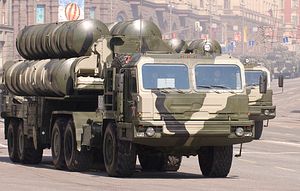India and Russia have reportedly concluded price negotiations for the procurement of five regiments of Russian-made S-400 Triumf advanced Air Defense Systems (NATO reporting name: SA-21 Growler) intended for service in the Indian military, according to local media reports.
“The negotiations for the missile deal have been concluded. The financial component has been finalized,” a top government official involved in the talks told Indian media on May 27. The official also noted that the deal will likely be publicly announced during a summit meeting between Indian Prime Minister Narendra Modi and Russian President Vladimir Putin scheduled for this October.
Indian and Russian officials are now reportedly trying to ascertain how to prevent the United States from sanctioning India under its Countering America’s Adversaries Through Sanctions Act (CAATSA) for acquiring Russian weaponry. The United States passed the CAATSA against Russia in August 2017 for purportedly manipulating the 2016 presidential election process.
While the imposition of sanctions by the U.S. on India is highly unlikely, New Delhi’s decision to move ahead with the S-400 acquisition could impact future U.S.-India defense deals including the possible procurement of armed U.S.-made Predator drones or the establishment of joint aircraft production facilities.
“The acquisition of this technology will limit, I am afraid, the degree with which the United States will feel comfortable in bringing additional technology into whatever country we are talking about,” William Thornberry, the Chairman of the House Armed Services Committee, said in an interview with local media this week. The acquisition of the S-400, “threatens our ability to work interoperably in the future,” he added.
India and Russia concluded an inter-governmental agreement for the purchase of the S-400s in in 2016 (See: “India and Russia Ink S-400 Missile Air Defense System Deal”). The total contract value is estimated at around USD $5.5 billion. As I explained in February 2018:
The standard S-400 battery consists of four transporter erector launchers (TELs), four launch tubes per TEL, in addition to target acquisition and engagement (fire control) radar systems and a command post. (With an additional fire control radar system, a battery can consist of up to 12 TELs.) Two batteries make up a S-400 battalion (also known as a S-400 division), whereas a S-400 regiment consists of two battalions.
Additionally, I explained the S-400s basic technical characteristics including its various surface-to-air missiles:
In comparison to its predecessor, the S-300, the S-400 air defense system features an improved radar system and updated software; it can purportedly fire four new types of surface-to-air (SAM) missiles in addition to the S-300’s 48N6E, a vertical tube launched, solid fuel, single stage SAM with an estimated range of 150 kilometers (93 miles), and the improved 48N6E2 missile with a reported range of 195 kilometers (121 miles).
One of the S-400’s new missiles is the so-called 40N6E SAM with an estimated operational range of 400 kilometers (248.5 miles) and an altitude of up to 185 kilometers (607,000 feet). The missile is reportedly capable of exo-atmospheric interception of intermediate-range ballistic missile warheads in their terminal phase. However, it is unclear whether the weapon is operational in Russia yet and no images of the 40N6E SAM have surfaced so far.
The S-400 is also armed with an improved variant of the 48N6E2 with an alleged range of 250 kilometers (160 miles). The air defense system can also fire two additional missiles, the 9M96E and 9M96E2 with respective ranges of 40 km (25 miles) and 120 km (75 miles). Improved S-300 air defense systems such as the S-300PMU-2 Favorite … can purportedly also fire the 9M96E and 9M96E2.
It is still unclear what missiles Russia will supply the Indian military with. Once inducted, the Indian military will likely station three S-400 regiments in the west of India facing Pakistan, and two regiments in the east in close proximity to the Sino-Indian border.
































